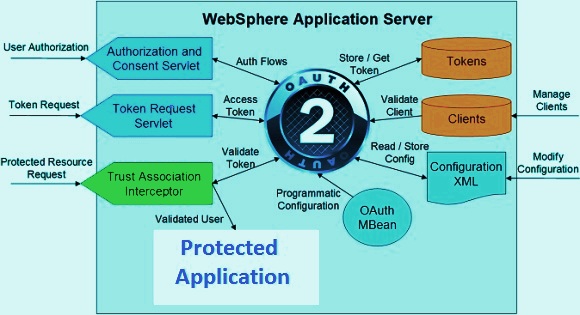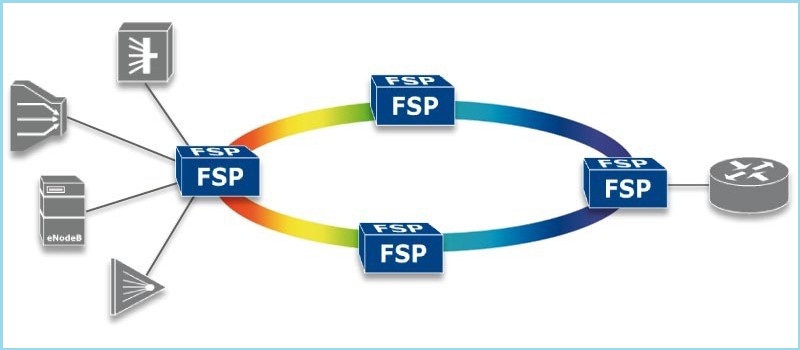


WebSphere Application Server is a software product which helps to perform the role of a web application server. WebSphere is a flagship product and a set of Java-based tools by IBM which allows customers to create and manage sophisticated business Web sites. It was originally created by Donald F. Ferguson, who later became CTO of Software for Dell and the first version was launched in 1998.
While the central WebSphere tool is known as WebSphere Application Server (WAS). WAS is an application server that helps the customer to connect Web site users with Servlets or Java applications. A Servlet is a Java program that runs on the server rather than on the user's application as Java applets do. Servlets are developed to replace the traditional common gateway interface (CGI) scripts. These scripts are usually written in C language, Practical Extraction or Reporting Language to run much faster and to control all other user requests that run in the same process space.
In addition to Java, WebSphere also supports the open standard interfaces such as Common Object Request Broker Architecture (CORBA) and Java Database Connectivity — JDBC. WebSphere is designed to use across different operating system platforms. You have an option of selecting the version suitable for your business purpose, as one edition of WebSphere will be offered for small to medium size businesses and another edition is for larger businesses with a huge number of transactions. It also has a Studio, which is a developer's environment added with additional components which allow creating web pages’ for a website and you can also the web pages accordingly. Both the versions support Solaris, Windows NT, OS/2, OS/390, and AIX operating systems.
While the WebSphere Studio includes a copy of the Apache Web server; which helps the developers to test Web pages and Java applications at any given time.
What is WebSphere?
The moment you ask this question, the first thing that strikes in your mind is WebSphere is an application server; but in reality, WebSphere is the name of the product in IBM family. IBM has many more products under the brand name WebSphere, here are some of them WebSphere Application Server, WebSphere MQ, WebSphere Message broker, WebSphere process Server, WebSphere business modeler, WebSphere business monitor, WebSphere integration developer, WebSphere partner gateway.
WebSphere Application Server Architecture
WAS is built using Open standards such as Java EE, XML, and Web Services. WebSphere application is supported on the following platforms; Linux, Windows, AIX, Solaris, IBM i and z/OS. It was started with Version 6.1 and the latest version is Version 8.5. While the open and standard specifications are aligned across all the platforms. Platform utilization is to an extent it takes place, but now it is done below across all open standard specifications line.
Security
The WebSphere Application Server security model is based on the services provided by the operating system and as per the Java EE security model. WebSphere Application Server provides implementations of user authentication and authorization mechanisms given that support for various user registries:
• Local operating system user registry
• LDAP user registry
• Federated user registry (version 6.1)
• Custom user registry
The authentication mechanisms supported by WebSphere are
...
Read More

Digitalization, digital networking, research, network automation, education and educational networks; are all these the buzz words of recent technology and for education institutions? Why everyone is talking about digitalization and networks, how are these both interconnected; and what is network automation and education networks are what we are going to know on this blog today .
While what the smaller research say about the education networks and individual campus networks; we can say that both stand for the same aim which is implementing education through current network automation strategies and tools. Are these tools, strategies, and significant efficiencies or the network automation wave more hype than these smaller institutions?
Let us look at some of the regional networks, how they are succeeded and what are the challenges involved in this path of deploying various network automation with relatively small and outsourced staff and support. Also discussed will be the experience of working with this diverse technology and how it increased the awareness about the possible proposed value of network automation and how regional’s can assist smaller schools through this network path.
Digital learning and collaboration have become an essential part of today’s education. From k-12 schools are implementing the methods of digital learning. These blended learning methods and one to one computing programs are reshaping the classroom studies and engaging more students to become tech-savvy’s. The higher educational institutions are announcing BYOD- which means bring your own device concept; students are also allowed to use their smart phones, laptops, tablets and other gadgets to be connected. This helps the institutions to meet the unprecedented demand for connectivity with high performance and to get recognized as highly reliable campus and data network center solution provider.

Challenges:
The hike of latest technologies, mobile devices and growing appetite for applications and rising security concerns are placing new burdens on educational networks. To meet these challenges, schools are expanding their networks to meet student and faculty expectations for high performance, highly reliable, and always-on connectivity.
The school network is always mission-critical, and downtime will be more and un-tolerable when class lectures, research projects, assignments are involved. We can see diversity and richness using these educational applications as learning is increasingly leveraging interactive curricula, collaboration tools, streaming media, and digital media. The success of the Common Core Assessments hugely depends on connectivity. The higher education, universities, and colleges that have poor quality, non-ubiquitous network access, quickly discover that this is affecting their registration/enrollment rates.
The other challenge is with the number of Wi-Fi devices and the types of devices students bring to a university or college campus; Students commonly have three or more devices like; smartphone, tablet, laptop, gaming device, or streaming media player and expect flawless connectivity. While higher education is deploying wireless IP phones for better communications, IP video cameras to develop physical security, and sensors for a more efficient environment. The projections for the Internet of Things, which will connect hundreds of billions of devices in a few short years, are nothing short of staggering.
The trends that educational networks are looking today for students, faculties and administrator expectations is that of for the connectivity which is rising and the complexity and cost of networking are also growing exponentially. In addition to this growth, the “adding on” to networking equipment for old designs is causing the network to become ever more fragile. IT budgets are tight, and technology necessities are growing faster than the funding.
What if schools took a step back and had a unique opportunity to proactively aim their networks to meet the challenges which hit today and tomorrow? What if deploying the network was simple, not a manual, time-consuming chore? What if your initial design and build could scale for years to come, without having to build configurations on the fly every time? What if networks were easier to plan and build, configure and deploy, visualize and monitor—and had automated troubleshooting and broad reporting?
The tools which are of high configurations help the educational networks are Juniper Networks, HP, CODE42, DLT, EKINOPS, Level 3, cloudyCluster, OSI and much more. It’s time to update the educational institutions towards the design, building, and maintaining the network and taking the advantage of automation and modern management tools to create scale, consistency, and efficiency.
...
Read More

Artificial intelligence has been spread over a very large area of computing since the beginning of the computer, but we are getting closer than ever with cognitive computing models. What are these models and why are we talking about it today.
Cognitive computing comes from a mash-up of cognitive science which is the study of the human brain and how it functions and a touch of computer science and the results will have far-reaching impacts on our private lives, healthcare, business, and more.
What is Cognitive Computing?
The aim of cognitive computing is to replicate human thought processes in a programmed model. It describes technology platforms that broadly speaking, and which are involved in self-learning systems that use data mining, natural language processing, and pattern recognition to mimic the way the human brain works. With the goal to automate the IT systems that are capable of solving the problems without requiring human assistance the Cognitive computing is growing very fast.
Cognitive computing systems use machine learning algorithms; which repeatedly acquire knowledge from the data fed into them by mining data for information. These systems treat the way they look for patterns and as well as the way they process data so they have become competent of anticipating new problems and modeling possible solutions.
Cognitive computing is used in numerous artificial intelligence applications (AI), including expert systems, neural networks, natural language programming, robotics and virtual reality. While computers are proved the faster machines at calculations and meting out the humans for decades; these machines haven’t been able to accomplish some tasks that humans take for granted as simple, like understanding natural language, or recognizing unique objects in an image. The cognitive computing represents the third era of computing: it from computers that could tabulate sums (the 1900s) to programmable systems (1950s), and now to cognitive systems.
The cognitive systems; most remarkably IBM and IBM +0.55%’s Watson, depend on deep learning algorithms and neural networks to process the information by comparing it to an education set of data. The more data the systems are exposed to, the more it learns, and the more accurate it becomes over time, and this type of neural network is a complex “tree” of decisions the computer can make to arrive at an answer.

What can cognitive computing do?
As per the recent TED Talk from IBM, Watson could ultimately be applied in a healthcare setting also, this helps the administrative department of healthcare to collate the span of knowledge around conditions, which include the patient history, journal articles, best practices, diagnostic tools, and many more. Through this, you can easily analyze that vast quantity of information, and provide your recommendations as needed.
The next stage is to examine, which will be proceeded by the consulting doctor, who will then be able to look at the evidence and based on the recorded evidence the treatment options will be released based on these large number of factors including the individual patient’s presentation and history. Hopefully, this will lead to making better treatment decisions.
While in other scenarios, when the goal is not to clear and you look to replace the doctor, and the doctor’s capabilities by processing the humongous amount of data available will not be retained by any human and thus providing a summary of potential application will be overdue. This type of process could be done for any field such as including finance, law, and education in which large quantities of complex data will be in need to be processed and analyzed to solve problems.
However, you can also apply these systems in other areas of business like consumer behavior analysis, personal shopping bots, travel agents, tutors, customer support bots, security, and diagnostics. We see that there are personal digital assistants available nowadays in our personal phones and computers like —Siri and Google GOOGL -0.21% among others, which are not true cognitive systems; and have a pre-programmed set of responses and can only respond to a preset number of requests. But, as tech is on high volume we will be able to address our phones, our computers, our cars, our smart houses and get a real time in the near future when thoughtful response rather than a pre-programmed one.
The coming future will be more delightful for us as computers will become more like humans and they will also expand our capabilities and knowledge. Just be ready to welcome the coming era when computers can enhance human knowledge and ingenuity in entirely new ways.
...
Read More

Stressing yourselves and struggling to grab the dream job is not that tough today if you carry confidence, knowledge and most importantly when you are a team player with all the skills in you. You need to stand in the competition and it can be strong when applying and be interviewing for your dream job. But it cannot be a stop to anyone when you have the desired skills. It’s a pretty rare thing that you are the only candidate for a job, in those cases, you will be approached by a company anyway, be rest assured and face the questions and the completion of the interview process. Try to get the edge on the other candidates who are with you by analyzing their skills and if they carry any extra degree. But how to do that is what we are speaking out on this blog. Try these simple ideas — here are some ways to help you stand-out from the other candidates.
Your Curriculum Vitae (CV)

Reaching out the consultancy or an employer is essential and the first challenge for anyone to get their dream job. But, this will only happen when your CV represents you better than what you are. This plays a vital role to get an interview call or a mail, and then it’s your task to present yourself and grab the job. Make sure that your CV is tailored to the job spec ified and the role offered.
Don’t Fail to prepare & prepare well to fail

Once your interview is secured, and you are all set to join your dream job. Set aside time to prepare well and try to get all the relevant information about the company you are joining. This is the exercise you need to follow before you are hitting the interview and the time you are joining the company too. Before you are hitting the interview you need to make a note of the company’s history, teams, what are they into and what they do to others?
STAR Method

This is a simple method, which will help you to answer the most challenging and competency based questions. Today organizations are very keen to know what was the situation that you have met, how did you deal with it and what was the solution you gave. This is the stage you can prove yourself and how your employer did grade you to be the best player.
A situation or Task: Describe the situation you were confronted or the task; that you needed to accomplish in a shorter time.
Action: Brief how you reacted towards the situation and what you did; this is where the interviewer will be looking for the explanation and how you used skills and attribute that they are testing. Make sure that you take the personal approach as the interviewer needs to hear about your actions, not the teams.
Result: Explain how it all ended. Use this as an opportunity to describe what you accomplished and learned from the situation.
Appearance

No matter what the role is or the organization you are attending; remember that for all little things you need to pay. Make sure for the grammar check, spell check in your CV and what you are wearing. Do not select the clothes which make you feel sick, wear right clothes that fit you the best.
Most of the people aren't going to notice the difference, but some will, of course, do it; but don't go to impress people, which will land you somewhere else. The most important thing is to look professional. Tattoos covered up. One pair of earrings for women; or none is also fine, no earrings for men. No facial piercings at all .
Attitude

Your attitude plays everything when you are facing interviewer. Carry positive body language and attitude. Greet, smile and give the interviewer a firm handshake when you meet him or her. Make eye contact and actively engage with the interviewer, and lean slightly towards the interviewer to show your engagement in the conversation. Do not look up or down, not even to the sides of the interviewer when speaking, as this can be interpreted as disinterest or apathy. Thank the interviewer sincerely for the time and opportunity and express your excitement about the employment possibility.
...
Read More

The Internet of Things (IoT) has quickly turned out to be one of the most adapted and maybe, most advertised jargons across IT & ITES industry. However, it is completely defensible and is backed up by the numbers. Beyond of its extensive range of benefits, the state of the art of this trend being involved in the IT sector is inevitable.
The IoT of things are not all-purpose devices, such as smartphones and computers, but dedicated objects, such as vending machines, jet engines, connected soap dispensers and many other countless examples.
IoT will have a great impact on the economy and many enterprises will look into transforming their businesses into digital and facilitate their business models by improving efficiency to generate good ROI. It’s a tradition that enterprises always look up for successful trends and for sure Industries are looking at IoT, but the implementation is still premature. Even though there is some immaturity, but there is still some evidence of planned uses across a wide range of industries. We may find an answer from these existing evidence to the question of the hour, what needs to be done to build IoT at the enterprise level.
Sensors
Objects that contain sensors found useful in all studies, for example, you can fix a sensor to the products in a grocery store and if the item is spoiled it will give you a buzz to replace the item, the cost of purchase and installation of a sensor is relatively cheap and it also reduce the stress on the workforce.
Connectivity
You can always stay connected to your IoT device via your smartphone or through a hub or the device itself contains the Internet connectivity.
Processors
Without a processor there is no computing or a smart device. IoT devices will have capabilities of computing and storing relevant data passed on to it. There is a need to equip these devices with some useful features, so there is a need of advanced processors equipped with these devices.
Energy-efficiency
Think about the high-end business models, where there will a lot of flow of customer and immense pressure on your workforce, you need a device which has the conservative amount of energy, which will not ask you for a battery charger or replacement battery during peak hours.
Cost Effectiveness
The Business goal of IT companies is providing the users with the technology and features that they needed the most. However, there will be a significant cost for maintaining and supporting the user’s technology. IoT is the answer to reducing the signification cost and ensure flawless deliverability in the IT process or project.
Quality Standards
You need to operate your devices under harsh outdoor atmospheric conditions for a long time. There should be proper parameters and quality checks on the (IoT) devices produced by the industries.
Security
Securing your device or network is a critical mission, Devices that are associated with a network through IP’s have immense threats of being hacked/spoofed. Managing ID’s and access, saving the databases are critical to the triumph of the IoT. However, traditional approach and old school techniques cannot cope with the complexity that the IoT needs from the enterprise. It is the time for Business leaders and technology giants to reconsider their approach towards cyber security, and they should raise the curtains for the new set of security rules.
...
Read More